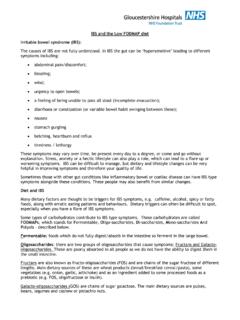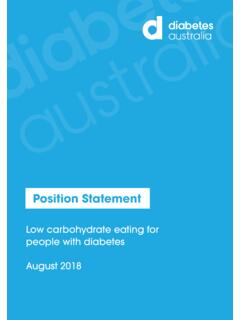Transcription of Glycaemic index of foods - Queensland Health
1 This is a consensus document from Dietitian/ Nutritionists from the Nutrition Education Materials Online, "NEMO", team. Disclaimer: Reviewed: January 2014 Due for review: January 2016 Glycaemic index of foods What is the Glycaemic index (GI)? The GI is a ranking of carbohydrate foods from 0 to 100 based on how quickly and how much they raise blood sugar levels after being eaten.
2 This is related to how quickly a carbohydrate containing food is broken down into glucose. Low GI foods produce a slower, lower rise in blood sugar levels. High GI foods produce a faster, higher rise in blood sugar levels. Blood Glucose Level High GI, Lucozade Low GI, Milk Time Low GI foods have a GI of less than 55 Medium GI foods have a GI between 55 and 70 High GI foods have a GI greater than 70 Why is the GI important? Considering the GI of carbohydrate foods can help with good diabetes management as: Lower GI foods produce lower, more stable blood sugar levels and therefore can help improve control of diabetes. Higher GI foods produce higher, faster rising blood sugar levels.
3 Lower GI foods also help you to feel fuller for longer, which can help to control appetite and assist with weight management. This is a consensus document from Dietitian/ Nutritionists from the Nutrition Education Materials Online, "NEMO", team. Disclaimer: Reviewed: January 2014 Due for review: January 2016 Factors affecting the GI of foods There are many factors that have an effect on the GI of carbohydrate containing foods .
4 The type of starch present The type of sugar present - fructose (fruit sugar) and lactose (milk sugar) both have a lower GI than sucrose (table sugar) The amount of water soluble fibre. The more soluble fibre a food contains, the lower the GI value. Storage time and ripeness will affect the GI value; the more ripe a fruit or vegetable is, the higher the GI value. Cooking and processing food will usually increase the GI as there is less work required by the body to break the carbohydrates down. For example, juice has a higher GI value than whole fruits.
5 Adding acidity to the food will lower the GI ( adding lemon juice). Fat and protein consumed in the same meal will decrease the GI of a food or meal. Remember, GI is not a reflection of how healthy a food is. Fat content - foods high in fat often have a low GI ( chocolate or corn chips) and should only be included occasionally. The amount of food eaten- a small amount of a high GI food watermelon may only have a small effect on blood sugar levels. The quality of food- always aim to eat a wide range of carbohydrate containing foods including wholegrain breads and cereals, fresh fruit and vegetables and dairy which provide important nutrients and fibre.
6 Recommendations for using GI in your diet Aim to include at least 3 low GI foods throughout the day, ideally one with each meal or snack. When eating high GI foods , try to combine these with a low GI food in order to decrease the overall GI of a meal. Not all the carbohydrates you eat need to be low GI. This is a consensus document from Dietitian/ Nutritionists from the Nutrition Education Materials Online, "NEMO", team. Disclaimer: Reviewed: January 2014 Due for review.
7 January 2016 GI ranking of common carbohydrate foods Low GI Medium GI High GI Breads Mixed grain bread, low GI white bread The One, soy and linseed bread, chapatti, oat bran bread, fruit loaf / raisin bread, country life low GI gluten free bread Wholemeal bread, pita bread, crossiants*, rye bread, crumpets, taco shells White bread, gluten free white bread, bagels*, Lebanese bread Breakfast cereals Rolled oats / porridge, All Bran, muesli, Special K Weet-bix, Vita Brits, bran flakes, Sultana Bran, Just Right, Nutrigrain Rice Bubbles, Corn Flakes, Coco Pops*, Fruit Loops*, instant oat porridge, Fruity Bix Grains Pasta, ravioli*, instant noodles*, rice noodles, rice pasta, quinoa, semolina, 2 minute noodles* Cous cous, gnocci, rice vermicelli, dongarra rice, basmati rice, long grain white rice (boiled) Brown rice, jasmine rice, sticky rice (sushi rolls)
8 , quick rice, congee, corn pasta Biscuits Vita Wheat crispbread, Jatz*, oatmeal biscuits, Snack Right fruit slice Ryvita, shredded wheatmeal, Milk Arrowroot, shortbread* Water crackers, Cruskits, rice cakes, rice crackers, corn thins, Saos Fruits Grapefruit, peach, apricot, apple, pear, plum, orange, grapes, banana, cherries, mango, dates Paw paw, rockmelon, sultantas, apricots, peaches (tinned in syrup), pineapple Watermelon, lychee Vegetables and legumes Sweet potato, taro, sweet corn, yam, most beans (kidney, red, baked, lima, soy), chickpeas, lentils Potato (mashed with butter or milk) White potato, parsnip, broad beans Dairy Milk, yoghurt, custard, ice Cream*, soy milk, Up and Go, Le Rice* Condensed milk*, Vaalia yoghurt drink Rice milk Extra foods Chocolate*, Snickers bar*, Milo, low GI sugar*, Nutella*, marmalade*, lasagne*, corn chips*, cashew nuts, sponge cake*, banana cake* Mars bar*, muesli bars*, Nesquik*, soft drink*, honey*, sugar*, pizza*, popcorn, potato chips* Lucozade*, Life Savers*, jelly beans*, roll ups*, waffles*, Skittles*, pretzel, donut*, pikelet, Gatorade* *These foods are high in fat and/or sugar and should be eaten occasionally.
9 These foods provide lots of extra energy (calories) and are low in nutritional value. More information can be found at.

















